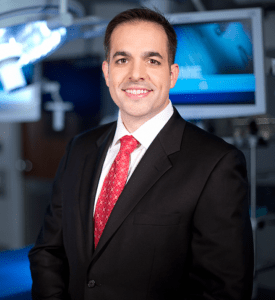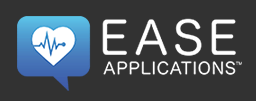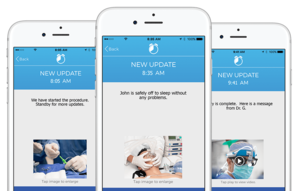Digital Messages From the Operating Room Ease Patients’ Anxious Family Members
eHealthcare Pulse
An Interview with Patrick de la Roza, CEO, EASE Applications
// By Jane Weber Brubaker //

Patrick de la Roza, CEO, EASE Applications
eHST: How did EASE get started?
PDLR: About three years ago, Dr. Hamish Munro, a pediatric anesthesiologist at Arnold Palmer Hospital, had a [patient with a] very nervous family. He decided to text them updates throughout the medical procedure. The reaction from the family was unbelievably positive. His partner, Dr. Kevin de la Roza (my brother), started texting families during surgery, too. People were unbelievably moved by simple updates letting them know what was happening throughout the medical procedure. They brought me on board and we realized we needed to create something that was more sustainable, something that would be HIPAA compliant and without using their personal phones. That was three years ago.
eHST: Who actually sends the messages from the OR?  PDLR: It’s typically the circulating nurse that sends updates about every 30 minutes on what’s happening, so anything from when the patient first falls asleep, to we made an incision and the surgery is underway.
PDLR: It’s typically the circulating nurse that sends updates about every 30 minutes on what’s happening, so anything from when the patient first falls asleep, to we made an incision and the surgery is underway.
eHST: I saw the video. It has a lot of emotional impact.
PDLR: There isn’t anybody that doesn’t connect with this. We’ve all sat in a waiting room in the dark, dying for an update, just staring at the door, waiting for it to open. This removes that anxiety. One of the things that our data shows is that about every 30 minutes, if you haven’t received an update on your relatives, you start getting nervous. At one of our hospitals—and I think it’s close to 3,000 cases—97 percent have said that EASE reduced their anxiety.
eHST: What happens if there’s bad news from the OR?
PDLR: EASE is not meant to replace in-person communication. What you do if you’re a physician is what you normally do. You focus on the patient, and you correct the problem. Then you assess. Is it appropriate to update through the app, or do you need to update in person? One of the things EASE does is it removes people from the waiting room. You no longer feel confined to sit there because you know you’re going to get updates. If it’s an adverse event and the physician needs to update families, he or she says, “Please meet us at the nurse’s station in 10 minutes. We want to update you in person.” We actually surveyed a lot of families and we asked them, “What would you want us to do?” And they all said the same thing: “Correct the problem, and then update us on what’s going on.”
eHST: What hurdles have you had to overcome to get hospitals to adopt EASE?
PDLR: It’s been a very interesting journey. EASE is a culture change. If you think about a hospital, the one black box is the operating room. You’re allowed to be with your significant other during labor, you’re allowed to go to a lot of places, but the one place people don’t go is the operating room.
So when we first started saying we want to send updates, pictures, and videos from the operating room, there were some physicians that said, “This is amazing, I’m in.” There were some that were a little skeptical but said, “I’m intrigued, let’s try it.” And then there were some that said, “Not in my OR.”
What we’ve seen is that you have early adopters and innovators that jump on it, and they prove to the others that this is the right thing to do. We have an 80 percent response rate on our consumer surveys. Families are very passionate and tell us how much they love EASE and why they think it’s great. All we have to do is share that data with physicians that are a little bit more apprehensive, and soon enough, they start using it as well. EASE is a very viral thing. Families will talk about it.
eHST: What other obstacles have you faced?
PDLR: The greatest thing about EASE is how simple it is to use. You download it to an iPad that the nurse uses and you’re ready to go. So it’s not a heavy IT play in any way. But IT still has a lot of checkboxes, so it’s a little slow to get in.
eHST: You are not just sending text messages. You’re also sending photographs and videos. How far does that go?
PDLR: They actually will send pictures of the procedure, a real video of the heart beating after it’s come off bypass and other appropriate images. EASE is about informing you and educating you on the process.
The first time I saw some of the messages that the doctors and nurses were sending, I thought, “This is crazy. Families are not going to want to see this.” But one of our most beautiful testimonials is a mom saying, “I was sent a video of my son’s heart beating, and it was one of the most beautiful things that I have ever seen in my life.”
About 98 percent of our families in more than 2,500 cases at one hospital said the texts, pictures, and videos were appropriate. We always accompany pictures and videos with a simple text update, because if you are not a clinical person, you are not going to understand complex medical terminology. We try to keep it simple so that you understand.
 eHST: How do you train doctors and nurses to use plain English?
eHST: How do you train doctors and nurses to use plain English?
PDLR: We have a very comprehensive training program and protocols. Our doctors will physically come on-site and work with the clinical folks to teach them. The app has a 200-character limit per message, so it forces you to be condensed, kind of like a tweet.
We just ask the nurse, “What would you want to know if this was your child or your mom having surgery?” When you frame it that way, and you show them proper examples, the nurses embrace it.
We very intentionally want to keep messages custom. There’s a big difference between saying “Grandpa Jim is doing well; he’s in recovery,” as opposed to, “Patient in recovery.”
eHST: Who can receive the messages?
PDLR: Let’s say my daughter is having surgery. I can invite my wife, my parents, my two brothers, and any other friends of mine who want to know what’s happening to my little one to all get updates at the same time. The update lasts 60 seconds on your phone before it disappears, and nothing is saved. Messages are deleted and purged.
eHST: So 60 seconds and then they’re gone?
PDLR: Yes, each message.
eHST: Is EASE used exclusively in pediatric hospitals?
PDLR: No. For example, at Orlando Health where this started, EASE is used system-wide on all of their adult campuses. We started in adult cardiac. We didn’t know if families were going to want to see the same type of information. Would people be just as passionate about this? It has been just as strong. We’ve done all specialties now, all types of procedures—GYN procedures, orthopedic procedures, and cardiac procedures. We’ve done the most complex. It doesn’t get more complex than pediatric open-heart surgery, and that’s where this was born.
eHST: How many hospitals are you in?
PDLR: We’re in about 20 hospitals now. We have roughly another 25 that are in different stages of starting or contract negotiations. We have some folks in pilots as well. We are in Nationwide Children’s Hospital, St. Louis Children’s Hospital, Nemours, United Regional Health Care, and Texas Children’s Hospital. We’re going to be system-wide in Orlando Health.
eHST: What are the implications for marketing?
PDLR: We think this has great potential from a marketing perspective, especially if you are the first in the market. We’ve had several people inquire about exclusivity in different markets. It’s saying we’re putting patients and families first, and we’re bringing this technology into all of our surgeries. You can spend millions of dollars on a pretty fountain and a pretty building. But do those really improve the experience and can you prove that?
The other part of it that’s powerful from a marketing perspective is that between 70 and 80 percent of families have said the availability of EASE will influence their choice of hospital. Once they’ve had this, they can never go back, like if I took texting away from you today.
Jane Weber Brubaker is Editor of eHealthcare Strategy & Trends.

